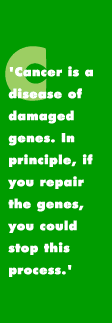 DNA
repair shop But sometimes mistakes happen, and understanding why is a key question that must be answered before gene therapy can become a reality. To use gene therapy to treat a disease, some researchers put the "good" gene into a modified virus or a lipid (fat cell), which sticks itself randomly into the DNA of an organism. Besides being somewhat hit or miss, there's a chance the new gene will end up disrupting some other gene. Plus, this approach doesn't work where the damaged or bad gene is dominant. It would be better if scientists could mimic homologous recombination, which Kowalczykowski calls "the surgical precision method of gene therapy." That way enzymes would read the chromosome for sequencing information and splice the good gene back where it belongs on a segment of DNA. But right now, scientists can't manipulate this process very well. "Everyone has their strategies but we don't know enough about homologous recombination to do it efficiently enough to be practical," said Kowalczykowski. Kowalczykowski's work plays an important role in this field, and in the developing affiliation between the UC Davis Cancer Center and Lawrence Livermore National Laboratory. For the past two years he has been part of a team that included researchers from UC Davis and Lawrence Livermore in a quest to study a DNA helicase called RecBCD. RecBCD is an enzyme that attaches to DNA and moves along the molecule, unwinding the double helix as it goes. This allows other enzymes to access the DNA strands so that the DNA sequence can be copied or repaired.
Home |
Table of Contents |
To our Readers |
Building on Basics UC Davis Health System | © 2000, 2001, 2002 UC Regents. All rights reserved. |
 |
